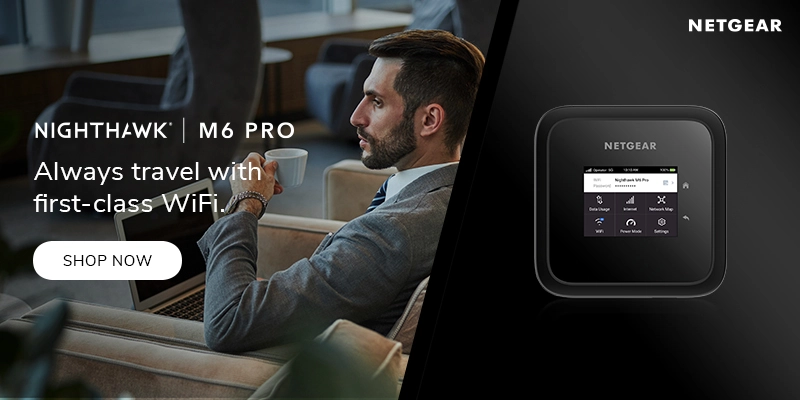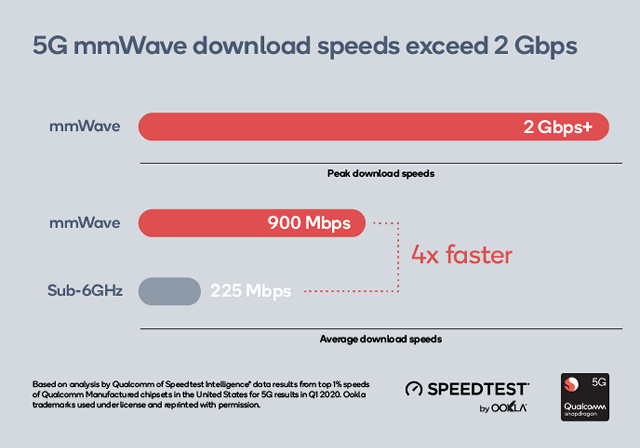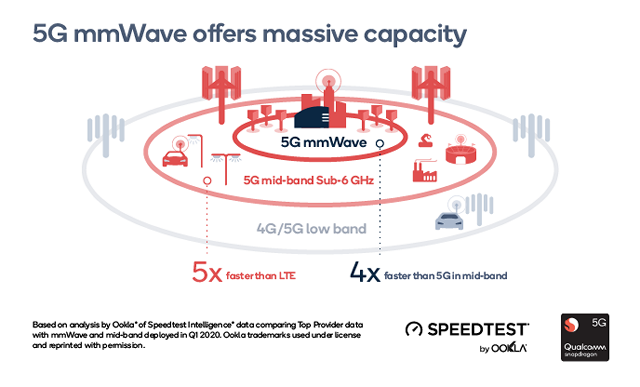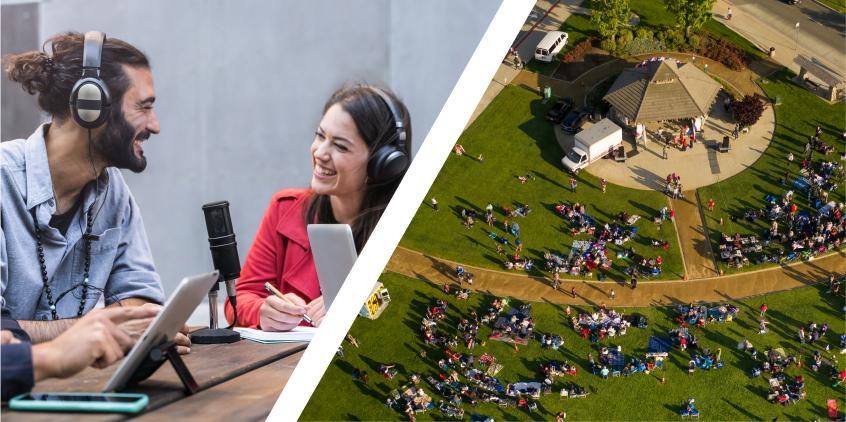
5G mmWave: Delivers Low Latency for Enhanced Performance
Experience the latest 5G mmWave technology for a strong internet connection, fast downloads, quick app responses, and ground-breaking speeds.
What is 5G mmWave?
5G mmWave (millimeter wave) expands 5G technology to improve the user experience with greater capacity, multi-gigabit internet speeds, and low latency, especially in crowded WiFi areas. These expanded capabilities, offered on the Nighthawk® M6 Pro WiFi 6E hotspot, are ideal for businesses and consumers to use for video conferencing in real time, online gaming, downloading large files, and sharing critical and highly sensitive data.
Who Benefits from 5G mmWave?
5G mmWave technology is suitable for a wide range of use cases, including:
- Social media influencers who require an ultra-fast connection to stream content, anywhere
- Gamers desiring ultra-low latencies for a lag-free online gaming experience
- Professionals looking for a temporary high-speed connection for video distribution at events
- Businesses, such as food trucks, needing a secure, reliable internet connection to make sales
- First responders needing a strong internet connection to stay in contact with each other during emergencies
- Consumers looking for a wireless connection at “fibre-speeds” for apartments and homes in densely populated cities
- AR/VR applications in sporting events, education, or healthcare
- Difference between 5G mmWave and 5G Sub-6 GHz
- Compared to the 5G Sub-6 GHz frequency bands widely available today, 5G mmWave delivers more bandwidth, faster WiFi speeds, and minimal delay when using heavy-data processing apps such as HD video. It has a shorter, more concentrated range that can only be accessed close to the tower, limiting the ability to penetrate walls*. 5G mmWave delivers better performance in crowded areas with a large number of WiFi users, such as outdoor festivals, construction areas, stadiums, and other public, urban spaces.

The next-generation technology after 4G LTE, 5G Sub-6 GHz allows users to experience the 5G higher performance and improved efficiency where mmWave is not available. It also has a longer range than 5G mmWave which allows the signal to easily reach inside buildings.
With the Nighthawk M6 Pro that supports both 5G mmWave and Sub-6 GHz, users can enjoy all the advantages of 5G mmWave (where coverage is available) and seamlessly switch to 5G Sub-6 GHz and 4G LTE for full coverage when on the go or inside buildings.
5G-Sub-6 GHz: A balance between performance and range.
5G mmWave: Multi-gigabit speeds with lower latency at short range.

What is the range of 5G mmWave?
5G mmWave operates on a higher frequency with a shorter range up to 1 km (0.62 miles), which limits the ability for the signal to penetrate buildings. This means the hotspot needs to be close to the 5G mmWave tower with minimal obstruction.
When using your Nighthawk M6 Pro, it is recommended to place it as close to a window as possible and in line of sight of the 5G mmWave tower to get the best signal. Conversely, accessing the 5G Sub-6 GHz signal is not dependent on where your Nighthawk M6 Pro is positioned.

The NETGEAR ADVANTAGE
With 5G mm Wave already available in the US and Japan and rolling out through Europe and the UK, NETGEAR is again taking the lead by providing exceptional products that are uniquely engineered to take advantage of this new technology. Combining over 25 years of networking and mobile broadband experience, NETGEAR is launching the Nighthawk M6 Pro 5G WiFi 6E mobile hotspot to provide an ultra-fast, secure WiFi with superior performance, no matter where users are. With lots of power packed in this sleek design, everyone can have the confidence of always being connected for their streaming, social media, gaming, or work activities.
Footnotes:
*Connectivity range of 5G mmWave frequencies
Millimeter wave refers to frequencies above 24 GHz. The higher the frequency of the radio waves, the shorter the length of each wave. Due to the high frequency of millimeter waves, the range of typical low-powered devices is limited to less than 1 km (0.62 mi), making it difficult to penetrate buildings. In contrast, 3G and 4G networks can move further and penetrate better into building materials. Until recently, millimeter waves were used only in satellite and radar systems and were typically operated in the military and aerospace industry. However, as data consumption has substantially increased, the industry recognized the need to use mmWave in next-generation cellular networks.


Unlocked for ultimate flexibility
Nighthawk M6 Pro is unlocked, giving you the freedom to select the carrier of your choice. Simply get a SIM card and data plan that meets your needs. Traveling internationally? No sweat. M6 Pro supports international roaming in up to 125 countries. Learn more about countries that are supported by M6 Pro.


Work outdoors and in crowded areas
5G mmWave technology gives M6 Pro greatly improved performance and reliability in tricky outdoor spaces and crowded areas where interference used to be a problem‡.
FREQUENTLY ASKED QUESTIONS
What is a benefit of 5g mmWave technology?
Compared to the 5G Sub-6 GHz frequency bands widely available today, 5G millimeter wave delivers more bandwidth, faster WiFi speeds, and minimal delay when using heavy-data processing apps such as HD video.
What is mmWave 5g?
5G mmWave (millimeter wave) expands 5G technology to improve the user experience with greater capacity, multi-gigabit internet speeds, and low latency, especially in crowded WiFi areas. These expanded capabilities are ideal for businesses and consumers to use for video conferencing in real time, online gaming, downloading large files, and sharing critical and highly sensitive data.
Is 5G mmWave worth it?
5G mmWave is valuable and ideal for anyone needing the expanded capabilities of 5G including businesses and consumers to use for video streaming in real time, online gaming, downloading large files, and sharing critical and highly sensitive data.
What is the range of 5G mmWave?
5G mmWave range varies by use case and situation. 5G mmWave generally has a shorter, more concentrated range that can only be accessed close to the tower, limiting the ability to penetrate walls. 5G mmWave delivers better performance in crowded areas with a large number of WiFi users, such as outdoor festivals, construction areas, stadiums, and other public, urban spaces.
